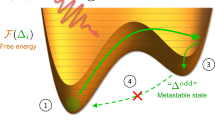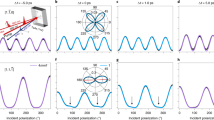Abstract
Light-induced supercurrents chart a path forward for the electromagnetic design of emergent materials phases and collective modes for quantum engineering applications. However, controlled spatial–temporal modulation of the complex order parameter characterizing such non-equilibrium macroscopic quantum states remains elusive. Such ultrafast phase-amplitude modulation can manifest via high harmonic modes beyond those allowed by equilibrium symmetries. Here, we drive moving condensate states via subcycle dynamical symmetry breaking achieved with nonlinear oscillating terahertz photocurrents. These non-equilibrium macroscopic quantum states with broken inversion symmetry are controlled via Cooper pair acceleration by asymmetric and multi-cycle terahertz photoexcitations. The observed supercurrent-carrying states evolve during a lightwave cycle and exhibit three distinguishing features: Anderson pseudo-spin precessions forbidden by equilibrium symmetry, strong high harmonic coherent oscillations assisted by pairing and long-lived gapless superfluidity with minimal condensate quench. Lightwave tuning of persistent photocurrents can be extended for quantum control of unconventional superconductors and topological matter, with implications on quantum gate and sensing functionalities.
This is a preview of subscription content, access via your institution
Access options
Access Nature and 54 other Nature Portfolio journals
Get Nature+, our best-value online-access subscription
$29.99 / 30 days
cancel any time
Subscribe to this journal
Receive 12 print issues and online access
$209.00 per year
only $17.42 per issue
Buy this article
- Purchase on Springer Link
- Instant access to full article PDF
Prices may be subject to local taxes which are calculated during checkout




Similar content being viewed by others
Data availability
The data that support the plots within this paper and other findings of this study are available from the corresponding author upon reasonable request.
Change history
12 July 2019
An amendment to this paper has been published and can be accessed via a link at the top of the paper.
References
Aoki, H. et al. Nonequilibrium dynamical mean-field theory and its applications. Rev. Mod. Phys. 86, 779–837 (2014).
Cea, T., Barone, P., Castellani, C. & Benfatto, L. Polarization dependence of the third-harmonic generation in multiband superconductors. Phys. Rev. B 97, 094516 (2018).
Matsunaga, R. et al. Higgs amplitude mode in the BCS superconductors Nb1 − xTixN induced by terahertz pulse excitation. Phys. Rev. Lett. 111, 057002 (2013).
Matsunaga, R. et al. Light-induced collective pseudospin precession resonating with Higgs mode in a superconductor. Science 345, 1145–1149 (2014).
Papenkort, T., Axt, V. M. & Kuhn, T. Coherent dynamics and pump–probe spectra of BCS superconductors. Phys. Rev. B 76, 224522 (2007).
Rajasekaran, S. et al. Probing optically silent superfluid stripes in cuprates. Science 359, 575–579 (2018).
Yang, X. et al. Terahertz-light quantum tuning of a metastable emergent phase hidden by superconductivity. Nat. Mater. 17, 586–591 (2018).
Nakamura, S. et al. Infrared activation of Higgs mode by supercurrent injection in a superconductor NbN. Preprint at http://arxiv.org/abs/1809.10335 (2018).
Luo, L. et al. Ultrafast terahertz conductivity probes of topologically enhanced surface transport driven by mid-infrared laser pulse in Bi2Se3. Nat. Commun. 10, 607 (2019).
Reimann, J. et al. Subcycle observation of lightwave-driven Dirac currents in a topological surface band. Nature 562, 396–400 (2018).
Fausti, D. et al. Light-induced superconductivity in a stripe-ordered cuprate. Science 331, 189–191 (2011).
Beck, M. et al. Transient increase of the energy gap of superconducting NbN thin films excited by resonant narrow-band terahertz pulses. Phys. Rev. Lett. 110, 267003 (2013).
Giorgianni, F. et al. Leggett mode controlled by light pulses. Nat. Phys. 15, 341–346 (2019).
Mansarta, B. et al. Coupling of a high-energy excitation to superconducting quasiparticles in a cuprate from coherent charge fluctuation spectroscopy. Proc. Natl Acad. Sci. USA 110, 4539–4544 (2013).
Pekker, D. & Varma, C. M. Amplitude/Higgs modes in condensed matter physics. Annu. Rev. Condens. Matter Phys. 6, 269–297 (2015).
Matsunaga, R. et al. Polarization-resolved terahertz third-harmonic generation in a single-crystal superconductor NbN: dominance of the Higgs mode beyond the BCS approximation. Phys. Rev. B 96, 020505(R) (2017).
Kozlov, V. V., Rosanov, N. N., De Angelis, C. & Wabnitz, S. Generation of unipolar pulses from nonunipolar optical pulses in a nonlinear medium. Phys. Rev. A 84, 023818 (2011).
Anthore, A., Pothier, H. & Esteve, D. Density of states in a superconductor carrying a supercurrent. Phys. Rev. Lett. 90, 127001 (2003).
Yuzbashyan, E. A. & Dzero, M. Dynamical vanishing of the order parameter in a fermionic condensate. Phys. Rev. Lett. 96, 230404 (2006).
Luo, L. et al. Broadband terahertz generation from metamaterials. Nat. Commun. 5, 3055 (2014).
Yang, X. et al. Ultrafast nonthermal terahertz electrodynamics and possible quantum energy transfer in the Nb3Sn superconductor. Phys. Rev. B. 99, 094504 (2019).
Semenov, A. V., Devyatov, I. A., de Visser, P. J. & Klapwijk, T. M. Coherent excited states in superconductors due to a microwave field. Phys. Rev. Lett. 117, 047002 (2016).
Moor, A., Volkov, A. F. & Efetov, K. B. Amplitude Higgs mode and admittance in superconductors with a moving condensate. Phys. Rev. Lett. 118, 047001 (2017).
Hansen, E. B. Infinite conductivity of ordinary and gapless superconductors. Physica 39, 271–292 (1968).
Dzero, M., Khodas, M. & Levchenko, A. Amplitude modes and dynamic coexistence of competing orders in multicomponent superconductors. Phys. Rev. B 91, 214505 (2015).
Yang, X. et al. Nonequilibrium pair breaking in Ba(Fe1 − xCox)2As2 superconductors: evidence for formation of photoinduced excitonic state. Phys. Rev. Lett. 121, 267001 (2018).
Patz, A. et al. Ultrafast observation of critical nematic fluctuations and giant magnetoelastic coupling in iron pnictides. Nat. Commun. 5, 3229 (2014).
Patz, A. et al. Critical speeding-up of non-equilibrium electronic relaxation near nematic phase transition in unstrained Ba(Fe1 − xCox)2As2. Phys. Rev. B 95, 165122 (2017).
Langer, F. et al. Lightwave valleytronics in a monolayer of tungsten diselenide. Nature 557, 76–80 (2018).
Stephen, M. J. Transport equations for superconductors. Phys. Rev. 139, A197 (1965).
Yang, F. & Wu, M. W. Gauge-invariant microscopic kinetic theory of superconductivity in response to electromagnetic fields. Phys. Rev. B 98, 094507 (2018).
Chou, Y. Z., Liao, Y. & Foster, M. S. Twisting Anderson pseudospins with light: quench dynamics in terahertz-pumped BCS superconductors. Phys. Rev. B 95, 104507 (2017).
Acknowledgements
Work at Iowa State University was supported by the Army Research Office under award no. W911NF-15-1-0135 (THz quantum spectroscopy). Work at the University of Wisconsin was supported by funding from the Department of Energy Office of Basic Energy Sciences under award no. DE-FG02-06ER46327 (structural and electrical characterizations) and Department of Energy grant no. DE-SC100387-020 (thin-film synthesis). The theory work at the University of Alabama, Birmingham was supported by the US Department of Energy, Office of Science, Basic Energy Sciences under award no. DE-SC0019137. The THz spectroscopy instrument was supported in part by the W.M. Keck Foundation.
Author information
Authors and Affiliations
Contributions
X.Y., C.V. and J.W. performed the experimental measurements, collected the data and analysed the results. C.S., J.H.K. and C.B.E. designed, fabricated and characterized the thin film heterostructures. M.M. and I.E.P. developed the theory and performed the quantum kinetic calculations. J.W. supervised the study, and wrote the paper together with I.E.P. and with help from all authors.
Corresponding author
Ethics declarations
Competing interests
The authors declare no competing interests.
Additional information
Publisher’s note: Springer Nature remains neutral with regard to jurisdictional claims in published maps and institutional affiliations.
Supplementary information
Supplementary Information
Supplementary notes and figures.
Rights and permissions
About this article
Cite this article
Yang, X., Vaswani, C., Sundahl, C. et al. Lightwave-driven gapless superconductivity and forbidden quantum beats by terahertz symmetry breaking. Nat. Photonics 13, 707–713 (2019). https://doi.org/10.1038/s41566-019-0470-y
Received:
Accepted:
Published:
Issue Date:
DOI: https://doi.org/10.1038/s41566-019-0470-y
This article is cited by
-
Visualizing heterogeneous dipole fields by terahertz light coupling in individual nano-junctions
Communications Physics (2023)
-
Gapless superconductivity in Nb thin films probed by terahertz spectroscopy
Nature Communications (2023)
-
Terahertz control of many-body dynamics in quantum materials
Nature Reviews Materials (2023)
-
Terahertz pulse-driven collective mode in the nematic superconducting state of Ba1−xKxFe2As2
npj Quantum Materials (2022)
-
Spectroscopic signatures of time-reversal symmetry breaking superconductivity
Communications Physics (2022)



